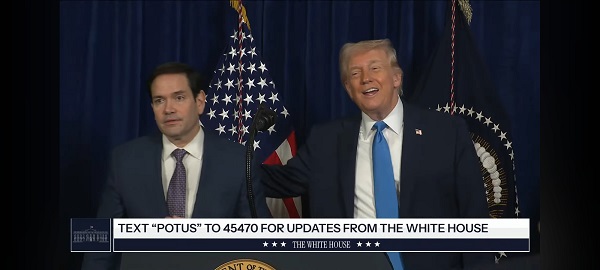Alberta
Province completely revamps funding for K-12 education – Adriana LaGrange announcement

From the Province of Alberta
Transforming K-12 education funding
A new way to fund Alberta’s K-12 education system will drive more dollars to the classroom where they can deliver the best outcomes for students.
The new model streamlines operations and directs more dollars to each school division. In the 2020-21 school year, every single division will see an increase in operational funding.
The model also provides more predictability in funding by changing from one-year enrolment counts to a moving three-year average, minimizing the need for mid-year adjustments to school budgets. The move will help school divisions plan their finances well in advance of the start of the school year.
“Alberta will continue to have one of the best-funded education systems in the country. This new model will drive more money to our school divisions for use in the classroom and provides them with the flexibility they need to meet the unique needs of their students. These changes will ensure our divisions continue to be equipped to provide our students with a world-class, high quality education.”
The new model also reduces red tape and gives more flexibility to school divisions to determine how to best invest taxpayer dollars. By simplifying the number of grants to 15 from the current 36, while still maintaining education funding, school divisions will have reduced reporting obligations and more leeway to direct funding to support the needs of students.
“This government is committed to cutting unnecessary red tape by one-third to reduce costs, speed up approvals and make life better for Albertans. I am thrilled that we are updating and streamlining the K-12 funding model, while maintaining robust measures to ensure money is being directed to the classroom. School boards can now spend less time on unnecessary reporting and administration work and more time focusing on students.”
Highlights of the new model include:
- Ensuring funds are directed to classrooms by providing a targeted grant for system administration, instead of a percentage of overall funding. This will standardize administrative and governance spending to within a reasonable range and maximize dollars intended for classrooms. The new model will also simplify grants to reduce red-tape for school authorities.
- Protecting our most vulnerable students by providing funding intended to support specialized learning needs or groups of students who may require additional supports from school authorities, including Program Unit Funding, funding for English as a Second Language students, French as a Second Language students, refugee students and First Nations, Métis and Inuit students.
- Better managing system growth, specifically enrolment growth and associated costs. Instead of funding based on a student count each year calculated in the fall, the new model will adopt a weighted, moving three-year average when calculating enrolment for funding. Using a weighted moving average means school boards will no longer have to wait until they have a confirmed number of students — typically at the end of September when the school year is already underway — to determine how much funding they will have for the year. This should minimize school authorities having to adjust their revenue forecasts and/or staffing levels throughout the school year.
- Providing funding predictability for school authorities by confirming their funding commitments from the province by the end of March each year, instead of the end of September when the school year has already begun. This will minimize the need for mid-year adjustments to budgets and staffing, create better alignment between the school year and the government’s fiscal year, and provide boards with more predictability in their planning and budgeting processes. A move to a block-funding model for small rural schools will also ensure the long-term viability of these schools where per-student funding does not provide adequate resources to properly deliver programs and services.
- Enhancing system accountability for school jurisdictions. The new model will include new accountability measures keeping school boards accountable for student outcomes, community engagement and continuous improvement.
“Our new funding model gives schools more of what they want – flexibility, stability and predictability. Flexibility to invest provincial dollars in areas that make the most sense for their communities. Stability in the number of grants and what the province expects for reporting. And predictability in their funding envelope to allow for better planning well ahead of each school year.”
The funding model for K-12 education has not changed in more than 15 years. The province met with each public, separate and Francophone school division, along with other system partners, in the fall of 2019 to discuss improvements to the way funding flows to school divisions. Overall, divisions wanted more predictability in their funding so they could better plan for each school year, more flexibility in how they spend provincial dollars based on their own needs in their communities, and reductions in provincial red tape.
Specific details for each grant and each school division’s funding will be available in Budget 2020, and will take effect for the 2020-21 school year.
“The College of Alberta School Superintendents recognizes the significant efforts Minister LaGrange has taken to engage with individual school authorities, the CASS Board and other education partners in the development of this new funding framework. The Minister’s willingness to listen and incorporate this feedback is clear as the new funding framework reflects a return to increased autonomy for local board decision making coupled with a reduction in the red tape school authorities have been challenged with in recent years. Finally, while we certainly recognize the fiscal challenges our province is currently experiencing, we are gratified to hear the Minister’s commitment in this budget to an increase in overall projected budget for every Alberta school authority over the previous year’s funding.”
“We appreciate that the government considered input from the education system as they developed the new funding model. This new model will reduce some of the red tape associated with accessing certain grants. It will also give school boards the ability to better predict the amount of funding they will receive in future years within the new, simplified model.”
“Alberta School Boards Association (ASBA) is pleased that government consulted with us on the new assurance and funding framework. We appreciate that government has released the funding framework, as ASBA requested, in advance of the budget. This allows boards time to review and understand the implications within the context of their local realities. ASBA will work closely with school boards and government to support implementation upon release of the budget.”
“We appreciate that Minister LaGrange has listened to our concerns and demonstrated her confidence and trust in the local autonomy of school boards to make decisions that are in the best interests of their students. While this is a complex matter that will take time for us to determine the impact on the classroom, we are optimistic that these changes will bring opportunity for our district. The reduction of red tape afforded by the new model will help reduce the complexity and workload involved in providing extensive and repetitious data, which in turn, will allow our teachers to focus on what is most important — our students.”
“Allowing important education funding decisions at a local level is a great step forward for parents’ choice in education and the ability of local school divisions — working with parents — to ensure key priorities are met. This new funding model will provide flexibility on how school divisions provide a precise and quality education to meet the needs of the students and the communities they serve.”
“We are pleased to see that Minister LaGrange has been responsive to our concerns for less red tape as well as targeted supports for small rural schools. We are also pleased to see her continued support for local board autonomy and the flexibility for our board to manage those decisions that most impact our students. We look forward to the release of the full budget details and are hopeful, even in difficult economic times, this new framework will continue to support our board as we provide high quality public education to our students.“
“We are pleased to see the government trust locally elected boards to make the right decisions for their students by providing us flexibility within our funding envelopes. The increased flexibility afforded by this new funding model will help us better allocate resources to address the unique needs of our students, while also cutting down on the significant red tape that was tied to the previous funding structure. We are looking forward to working with the government as this model rolls out for the 2020-21 school year.”
Alberta
Trump’s Venezuela Geopolitical Earthquake Shakes up Canada’s Plans as a “Net Zero” Energy Superpower

From Energy Now
By Ron Wallace
Get the Latest Canadian Focused Energy News Delivered to You! It’s FREE: Quick Sign-Up Here
Prime Minister Carney’s ‘well-laid plans’ for Canada to become a net zero energy superpower may suddenly be at risk – with significant consequences for Alberta. Recent events in Venezuela should force a careful re-examination of the economic viability of producing “decarbonized” heavy oil.
Having amassed military forces in the Caribbean throughout 2025 under Operation Southern Spear, on 3 January 2026 the Trump administration launched Operation Absolute Resolve, termed one of the most dramatic U.S. military actions in the Western Hemisphere since Operation Just Cause in Panama in 1989. Targeting multiple locations across Venezuela it led to the capture and removal of Venezuelan President Nicolás Maduro and his wife Cilia Flores. Initially held aboard the USS Iwo Jima they have been taken to the U.S. to face criminal charges for “narcoterrorism” and other offences.
In what has been termed a “$17 trillion reset”, Alberta may be at risk of losing its hard-won U.S. Gulf Coast (USGC) dominance to a resurgent rival – this coming at a time when Alberta and Canada are proposing to expend billions on “decarbonized” oil with punitive regulatory conditions that would not apply to Venezuelan, or any other international producers, of heavy oil. With U.S. forces capturing President Nicolás Maduro and President Trump declaring American administration of Venezuela to “get the oil flowing” again, the revival of Venezuela’s vast heavy crude reserves—over 300 billion barrels, the world’s largest—could flood the market with a cheaper, proximate supply tailored to U.S. refineries.
Historically, Alberta capitalized on Venezuela’s collapse when production there plummeted, due to mismanagement and sanctions, from 3 million barrels per day in the mid-2000’s to under 1 million today. This allowed Canadian heavy blends like Western Canadian Select to become the dominant feedstock for U.S. Gulf Coast refiners. In 2025, Canada supplied over one-third of the region’s heavy imports, tightening differentials and bolstering Alberta’s revenues.
A U.S.-revived Venezuelan oil industry, even if investment for infrastructure takes years to implement, would be a serious threat that risks displacing Canadian oil with lower-cost alternative supplies that also are geographically closer to U.S. refiners. This seismic geopolitical shift now confronts Prime Minister Mark Carney and Premier Danielle Smith as they attempt to implement their November 2025 Memorandum of Understanding (MoU), one that commits Alberta to produce “decarbonized” oil through massive carbon capture projects like Pathways Plus associated with Carbon Pricing Equivalency Agreements, are vastly expensive measures that could undermine Canadian price competitiveness against unsanctioned Venezuelan crude. Possibly of greater importance, Canadian insistence on “net zero” targets associated with pipelines and heavy oil production, policies that have caused significant capital flight from the Canadian energy sector, may further diminish the attractiveness of Alberta oil projects to international investors. Since 2015 Canada has experienced a flight of investment capital approaching CAD$650 billion due to lost, or deferred, resource projects – particularly in the energy sector. Will these policies and plans for the Alberta-Canada MoU allow Canada to become an “energy superpower” in this new age of international competition?
While short-term disruptions from the U.S. intervention might temporarily tighten heavy supply (and therefore benefit Canadian producers) the long-term prospect of U.S.-controlled Venezuelan oil production unquestionably represents a sea-change for international oil markets and may, potentially strengthen the economic case, if not urgency, for new Canadian Pacific pipelines to provide market access away from the U.S.
Historically, the U.S.–Venezuela oil trade relationship was a highly integrated system that was seriously disrupted, beginning in the 1970’s, by nationalization programs and by subsequent U.S. sanctions. The U.S. Gulf Coast (USGC) refinery complex is among the most highly developed in the world, one that required billions in investments for coking, desulfurization and hydrocracker units specifically designed to process heavy, sour Venezuelan crude. Importing approximately 40 million barrels of heavy crude per month in 2025, the USGC refiners scrambled to replace lost, sanctioned Venezuelan oil with Canadian Cold Lake, Mexican Maya and Brazilian heavy grades. Canada, offering a supply that was stable, pipeline‑connected and geopolitically low‑risk was the only producer with enough heavy crude to meaningfully offset those Venezuelan losses. In the twelve months ending February 2025, Canada supplied 13.6 million barrels/month representing 34% (the largest single source) to those U.S. refiners. As a result, Canadian Cold Lake and WCS differentials tightened with the Cold Lake WTI discount narrowing from $13.57/bbl (February) to $9.45/bbl (May).
However, with a federal government consumed with concerns about emissions and the attainment of an improbable national goal of Net Zero, and with terms in an MoU that will require material capital expenditures to produce “decarbonized” oil, Alberta and Canada would be wise to recognize that this geopolitical sea-change will affect not just prior assumptions about Canadian oil production (and MoU’s) but may yet work to change the fundamental economic assumptions of global oil economics.
Premier Smith has consistently argued that Canada needs to develop an “alternate reality” one in which Alberta oil producers and international export pipelines allow Canada to contribute to global energy security in ways that preclude “economic self-destruction.” In face of these geopolitical events, especially at a time of mounting national deficits, Canada may have precious little time to get its act together to effectively, and competitively, maintain and secure international markets for Alberta oil.
Dr. Ron Wallace is a former National Energy Board member who has also worked in the Venezuelan heavy oil sector.
Alberta
Alberta project would be “the biggest carbon capture and storage project in the world”

Pathways Alliance CEO Kendall Dilling is interviewed at the World Petroleum Congress in Calgary, Monday, Sept. 18, 2023.THE CANADIAN PRESS/Jeff McIntosh
From Resource Works
Carbon capture gives biggest bang for carbon tax buck CCS much cheaper than fuel switching: report
Canada’s climate change strategy is now joined at the hip to a pipeline. Two pipelines, actually — one for oil, one for carbon dioxide.
The MOU signed between Ottawa and Alberta two weeks ago ties a new oil pipeline to the Pathways Alliance, which includes what has been billed as the largest carbon capture proposal in the world.
One cannot proceed without the other. It’s quite possible neither will proceed.
The timing for multi-billion dollar carbon capture projects in general may be off, given the retreat we are now seeing from industry and government on decarbonization, especially in the U.S., our biggest energy customer and competitor.
But if the public, industry and our governments still think getting Canada’s GHG emissions down is a priority, decarbonizing Alberta oil, gas and heavy industry through CCS promises to be the most cost-effective technology approach.
New modelling by Clean Prosperity, a climate policy organization, finds large-scale carbon capture gets the biggest bang for the carbon tax buck.
Which makes sense. If oil and gas production in Alberta is Canada’s single largest emitter of CO2 and methane, it stands to reason that methane abatement and sequestering CO2 from oil and gas production is where the biggest gains are to be had.
A number of CCS projects are already in operation in Alberta, including Shell’s Quest project, which captures about 1 million tonnes of CO2 annually from the Scotford upgrader.
What is CO2 worth?
Clean Prosperity estimates industrial carbon pricing of $130 to $150 per tonne in Alberta and CCS could result in $90 billion in investment and 70 megatons (MT) annually of GHG abatement or sequestration. The lion’s share of that would come from CCS.
To put that in perspective, 70 MT is 10% of Canada’s total GHG emissions (694 MT).
The report cautions that these estimates are “hypothetical” and gives no timelines.
All of the main policy tools recommended by Clean Prosperity to achieve these GHG reductions are contained in the Ottawa-Alberta MOU.
One important policy in the MOU includes enhanced oil recovery (EOR), in which CO2 is injected into older conventional oil wells to increase output. While this increases oil production, it also sequesters large amounts of CO2.
Under Trudeau era policies, EOR was excluded from federal CCS tax credits. The MOU extends credits and other incentives to EOR, which improves the value proposition for carbon capture.
Under the MOU, Alberta agrees to raise its industrial carbon pricing from the current $95 per tonne to a minimum of $130 per tonne under its TIER system (Technology Innovation and Emission Reduction).
The biggest bang for the buck
Using a price of $130 to $150 per tonne, Clean Prosperity looked at two main pathways to GHG reductions: fuel switching in the power sector and CCS.
Fuel switching would involve replacing natural gas power generation with renewables, nuclear power, renewable natural gas or hydrogen.
“We calculated that fuel switching is more expensive,” Brendan Frank, director of policy and strategy for Clean Prosperity, told me.
Achieving the same GHG reductions through fuel switching would require industrial carbon prices of $300 to $1,000 per tonne, Frank said.
Clean Prosperity looked at five big sectoral emitters: oil and gas extraction, chemical manufacturing, pipeline transportation, petroleum refining, and cement manufacturing.
“We find that CCUS represents the largest opportunity for meaningful, cost-effective emissions reductions across five sectors,” the report states.

Fuel switching requires higher carbon prices than CCUS.
Measures like energy efficiency and methane abatement are included in Clean Prosperity’s calculations, but again CCS takes the biggest bite out of Alberta’s GHGs.
“Efficiency and (methane) abatement are a portion of it, but it’s a fairly small slice,” Frank said. “The overwhelming majority of it is in carbon capture.”

From left, Alberta Minister of Energy Marg McCuaig-Boyd, Shell Canada President Lorraine Mitchelmore, CEO of Royal Dutch Shell Ben van Beurden, Marathon Oil Executive Brian Maynard, Shell ER Manager, Stephen Velthuizen, and British High Commissioner to Canada Howard Drake open the valve to the Quest carbon capture and storage facility in Fort Saskatchewan Alta, on Friday November 6, 2015. Quest is designed to capture and safely store more than one million tonnes of CO2 each year an equivalent to the emissions from about 250,000 cars. THE CANADIAN PRESS/Jason Franson
Credit where credit is due
Setting an industrial carbon price is one thing. Putting it into effect through a workable carbon credit market is another.
“A high headline price is meaningless without higher credit prices,” the report states.
“TIER credit prices have declined steadily since 2023 and traded below $20 per tonne as of November 2025. With credit prices this low, the $95 per tonne headline price has a negligible effect on investment decisions and carbon markets will not drive CCUS deployment or fuel switching.”
Clean Prosperity recommends a kind of government-backstopped insurance mechanism guaranteeing carbon credit prices, which could otherwise be vulnerable to political and market vagaries.
Specifically, it recommends carbon contracts for difference (CCfD).
“A straight-forward way to think about it is insurance,” Frank explains.
Carbon credit prices are vulnerable to risks, including “stroke-of-pen risks,” in which governments change or cancel price schedules. There are also market risks.
CCfDs are contractual agreements between the private sector and government that guarantees a specific credit value over a specified time period.
“The private actor basically has insurance that the credits they’ll generate, as a result of making whatever low-carbon investment they’re after, will get a certain amount of revenue,” Frank said. “That certainty is enough to, in our view, unlock a lot of these projects.”
From the perspective of Canadian CCS equipment manufacturers like Vancouver’s Svante, there is one policy piece still missing from the MOU: eligibility for the Clean Technology Manufacturing (CTM) Investment tax credit.
“Carbon capture was left out of that,” said Svante co-founder Brett Henkel said.
Svante recently built a major manufacturing plant in Burnaby for its carbon capture filters and machines, with many of its prospective customers expected to be in the U.S.
The $20 billion Pathways project could be a huge boon for Canadian companies like Svante and Calgary’s Entropy. But there is fear Canadian CCS equipment manufacturers could be shut out of the project.
“If the oil sands companies put out for a bid all this equipment that’s needed, it is highly likely that a lot of that equipment is sourced outside of Canada, because the support for Canadian manufacturing is not there,” Henkel said.
Henkel hopes to see CCS manufacturing added to the eligibility for the CTM investment tax credit.
“To really build this eco-system in Canada and to support the Pathways Alliance project, we need that amendment to happen.”
Resource Works News
-

 Daily Caller2 days ago
Daily Caller2 days agoTrump Says US Going To Run Venezuela After Nabbing Maduro
-

 Frontier Centre for Public Policy9 hours ago
Frontier Centre for Public Policy9 hours agoIs Canada still worth the sacrifice for immigrants?
-

 Business2 days ago
Business2 days agoVirtue-signalling devotion to reconciliation will not end well
-

 Business9 hours ago
Business9 hours agoPolicy uncertainty continues to damage Canada’s mining potential
-

 Canadian Energy Centre9 hours ago
Canadian Energy Centre9 hours agoFive reasons why 2026 could mark a turning point for major export expansions
-

 International7 hours ago
International7 hours agoNetwork of Nonprofits with Marxist and CCP Ties, and Elected Socialists Race to Counter Washington’s Narrative of the Maduro Raid
-

 Opinion2 days ago
Opinion2 days agoHell freezes over, CTV’s fabrication of fake news and our 2026 forecast is still searching for sunshine
-

 COVID-191 day ago
COVID-191 day agoA new study proves, yet again, that the mRNA Covid jabs should NEVER have been approved for young people.



